This work aims at contributing to a new Sustainable Project Management (SPM) paradigm, focusing on the role of project managers as a key element. The contribution of this research has both practical and theoretical implications. It presents the first results of a project developed under the Erasmus+ program Think Twice, recommending a set of ecological practices to motivate and develop project managers’ skills to adopt Sustainable Project Management. Subsequently, supported by a literature review and content analysis of the data collected for this project, an original conceptual model is presented: the Project Management Triple Sustainability Cube. This tool is intended to guide project managers on their journey to sustainability in project management, comprehensively and systematically. To this end, the tool outlines guidelines for adopting comprehensive practices according to the triple bottom line sustainability vectors (environmental, social, and economic) relating to people, processes, and innovative solutions (go/no digital) throughout the project life cycle.
- project management
- digital era
- smart management
- sustainability
1. SusLitainable Developmenterature Review
Sustainable Development
2. Corporate Sustainable Management
Corporate Sustainable Management
3. Sustainability in Project Management
Sustainability in Project Management
-
“Sustainability by the project”—sustainability is considered in the specifications and design of the project outputs, considering the environmental, social, and environmental impacts of the project’s deliverables.
4. Dimensions of Sustainable Project Management
Dimensions of Sustainable Project Management
-
Triple Bottom Line Dimension [
-
“Sustainability of the project”—sustainability is addressed in project management processes, such as identifying and involving stakeholders, purchasing processes, business case development, project monitoring, project risk management, and project team building.
- 30]
- Project Development Life Cycle Dimension
-
Sustainability-oriented innovations dimension
5. The Pivotal Role of Project Managers in Sustainable Project Management—A New Paradigm
-
Intrinsic motivations for project managers: these are related to the innate stimuli of each professional associated with their concerns for the planet, scarcity of resources, equal opportunities, social justice, and climate change. Sustainability is considered the “right thing”, and therefore their motivations are not rewards, awards, or reputational gains. In this group, personal attitudes about sustainability predominate.
-
Task-driven: in this category, the integration of sustainability in PM is pushed by the definition of sustainable requirements and objectives, such as contractual clauses with incentive policies to achieve these aims. Normative behaviours expected by others predominate.
-
Pragmatic: these stimuli are very results-oriented, and therefore sustainability is integrated into PM when it adds value to project results. Sustainability is seen as an opportunity for the project.
6. Discussion and Conceptual Contribution
The challenges of the 21st century include combating the severe climate changes accelerated by human action in the Earth’s ecosystem and adapting humanity to energy and digital transitions, leaving no one behind. For these reasons, sustainability is the keyword nowadays. From the late 1960s, the ecological impact of human actions has been questioned, and nowadays its relevance to the fragility of the planet’s sustainability is evident. Nevertheless, given the importance of this ecological aspect, several authors insisted that the sustainability concept should go wider and be made more comprehensive, including social and economic dimensions along with environmental factors. Therefore, one cannot act in relation to one aspect of this triple bottom line vector without influencing the others. To respond to the current challenges, all the disciplines, all types of services, schools and academies, and rural and mechanical industries should acquire this triple global vision and adopt concrete measures, sometimes individually and sometimes as a group. The awareness of everybody’s involvement is crucial to reach the desired end, and this awareness leads to changes in working processes and relational methods. In the life cycle of product development and production, product managers have already been taking care of certain dimensions, including the ecological concerns, whether by limiting the use of certain types of raw materials, such as plastic, avoiding disposable materials, or offering alternatives for product destinations either by recycling the product or prepare it to act as a secondary raw material, ready for a new life. These actions widely adopted are not purely empirical but supported by the literature, for instance, the sustainability innovation cube of Hansen, Grosse-Dunker, and Reichwald [44] that adopts the triple bottom vectors approach to create a framework to evaluate sustainability-oriented innovations directed at encouraging product managers to act along the life cycle of a product, through manufacture, usage, and the end of the product’s life. This project intends to help promote the integration of environmental sustainability actions in project management daily practices. The results obtained so far were compiled as a set of practices oriented towards environmental sustainability, designated as the Curated Treasury. This list will allow project managers to make more conscious decisions about the impact of their projects with a similar project life cycle (as presented previously in Table 1). In addition, these practices promote the motivation of project managers to develop their projects in a more sustainable approach.Discussion and Conceptual Contribution
The challenges of the 21st century include combating the severe climate changes
accelerated by human action in the Earth’s ecosystem and adapting humanity to energy and digital transitions, leaving no one behind. For these reasons, sustainability is the keyword nowadays.
From the late 1960s, the ecological impact of human actions has been questioned, and
nowadays its relevance to the fragility of the planet’s sustainability is evident. Nevertheless, given the importance of this ecological aspect, several authors insisted that the sustainability concept should go wider and be made more comprehensive, including social and economic dimensions along with environmental factors. Therefore, one cannot act in relation to one aspect of this triple bottom line vector without influencing the others.
To respond to the current challenges, all the disciplines, all types of services, schools
and academies, and rural and mechanical industries should acquire this triple global
vision and adopt concrete measures, sometimes individually and sometimes as a group.
The awareness of everybody’s involvement is crucial to reach the desired end, and this
awareness leads to changes in working processes and relational methods.
In the life cycle of product development and production, product managers have
already been taking care of certain dimensions, including the ecological concerns, whether by limiting the use of certain types of raw materials, such as plastic, avoiding disposable materials, or offering alternatives for product destinations either by recycling the product
or prepare it to act as a secondary raw material, ready for a new life. These actions
widely adopted are not purely empirical but supported by the literature, for instance,
the sustainability innovation cube of Hansen, Grosse-Dunker, and Reichwald [39] that
adopts the triple bottom vectors approach to create a framework to evaluate sustainabilityoriented innovations directed at encouraging product managers to act along the life cycle of a product, through manufacture, usage, and the end of the product’s life.
This global and integrated vision should also be incorporated in the early stage of
project management and be brought inside organizations’ working methods, as supported by the literature state of the art outlined in previous Section.
To contribute to the introduction or extension of sustainability methods by project managers, the authors were deeply involved in the European Think Twice Erasmus +
project, described in Section 3. This project intends to help promote the integration of
environmental sustainability actions in project management daily practices. The results
obtained so far were compiled as a set of practices oriented towards environmental sustainability, designated as the Curated Treasury. This list will allow project managers to make more conscious decisions about the impact of their projects with a similar project life cycle (as presented previously in Table 1). In addition, these practices promote the motivation of project managers to develop their projects in a more sustainable approach.
The results are much more ambitious and not limited to an extensive list of good practices. This perspective leads project managers to the most suitable decision making considering the context of each project. Thus, one of the first steps to integrate sustainability into PM should be the analysis and selection of practices throughout the project life cycle, allowing the meeting of sustainability concerns in a customized and appropriate way to fit each project’s scope, as conceptually presented in Table 2.
Table 2. Conceptual model of Think Twice’s PDLC approach.
The PDLC approach avoids initial enthusiastic ecological intentions that will fade
or be forgotten in the management and implementation phases. Adopting sustainable
practices supporting the project’s life cycle contributes to the integration of sustainability in PM, not only comprehensively but systematically.
With the Think Twice results, the project manager is challenged to commit all stakeholders to act in conformity to ecological sustainability along the project development life cycle. What about the other two triple bottom dimensions, though?
With this question in mind and with the project results as a starting point, the authors identify an opportunity to go beyond the ecological analysis achieved by the TT project.
By applying the same methodology as before, the scope of the analysis was expanded
towards the triple bottom line sustainability approach to complement the project manager’s good practices.
The next section describes the conceptual model that led to a more extensive list of
good practices for project managers where the other two sustainability dimensions were included. The three sustainability dimensions approach was called the project management triple sustainability cube (of good practices).
4.1.
| Project Development Life Cycle * PDLC | ||
|---|---|---|
| Sustainability Dimension | Project Development Life Cycle | ||
|---|---|---|---|
| PDLC Management |
PDLC Implementation |
PDLC Dissemination and Evaluation |
|
| Ecological | An extensive list of good practices, Table 1 | ||
Conceptual Model to Assess Sustainability Dimensions in PM
| Sustainability Dimension | Project Development Life Cycle | ||
|---|---|---|---|
| PDLC | |||
| Project Development Life Cycle |
Variables | Triple Bottom Line Dimensions |
Management |
Management PDLC Implementation |
PDLC Dissemination and Evaluation |
||||||
|---|---|---|---|---|---|---|---|---|---|---|---|
| (PDLC-M) | |||||||||||
| Implementation (PDLC-I) |
Dissemination and Evaluation (PDLC-DE) |
||||||||||
| Management PDLC-M |
Travel (3) | Footprint of transnational face-to-face meetings vs. online meetings Use terrestrial means of transport to arrive at transnational meetings Searching for synergies when travelling |
| Building (6) |
| Ecological | V01: Process Green Indicators | ||||
| Reduction of organic waste and optimisation of heating costs and impact | Installation of energy control system for buildings/apply sustainable solution for heating the workplace Use of smaller units of renewable energy compared to conventional energy production facilities | ||||
| Ecological | Provide some alternative solutions, such as transformation of toilets with septic tanks into dry toilets, including recycling of brown, yellow, and grey water |
V02: Processes and System | Use of free water/saving tap water |
||
| Digital (2) | Cameras off during online meetings Impact of email attachments on energy consumption |
||||
| V03: Go/NoGo Digital | Tech (3) | Prolong the lifetime of a product and reduce your environmental footprint Choose products that allow you to prolong their lifetime and reduce your environmental footprint | |||
| Sustainability Dimension | Project Development Life Cycle | ||||||||
|---|---|---|---|---|---|---|---|---|---|
| (EcoS) | V01: Process Green Indicators | ||||||||
| PDLC-M | PDLC-I | PDLC-DE | PGI | P&S | GNgD | EcoS | V02: Processes and System | ||
| V03: Go/NoGo Digital | |||||||||
| SocS | Preventing tech waste through cloud computing | ||||||||
| Social (SocS) |
V01: Process Green Indicators | Office (9) | Choosing sustainable office supplies, minimising waste Sustainable or recycled office supplies Less printing, more energy efficient printers Using recycled paper Recyclable food packaging Creation of plant-based plastic products Reusing ink cartridges and toners Replacing plastic bottles with glass bottles Green procurement |
||||||
| V02: Processes and System | Other (1) | Use grants to fund investment in environmentally friendly practices | |||||||
| V03: Go/NoGo Digital | Implementation PDLC-I |
Working at your PC (3) | Green search engines/ Work offline when possible Sharing printed documents: copy or scan? |
||||||
| Economic (EncS) |
Transport/ Commuting (3) |
Carpooling Familiarise project managers with eco-friendly methods of movement (positive and negative aspects) Working from Home (online management solutions) |
|||||||
| V01: Process Green Indicators | Daily office routine (2) | ||||||||
| V02: Processes and System | Reduce water consumption at your workplace Zero-waste offices and coffee breaks |
||||||||
| V03: Go/NoGo Digital | Communication/ awareness (3) |
Raise awareness and make sustainability every employee’s responsibility Nurturing a sustainable mindset Work and meet in nature-focused co-working spaces |
|||||||
| Other (1) | Tech Symbiosis—Upcycling tech for the implementation of training and digital competences-oriented activities | ||||||||
| Dissemination PDLC-D |
Multipliers (3) | Ecological sustainability of online multiplier events compared to physical events Sustainable catering Sustainable event management, starting with transfer to and from the event, accommodation, local transport to the venues, and materials |
|||||||
| Physical aspects (1) | Reduce waste impact on the environment by adopting upcycled/recycled “gadgets” for project dissemination purposes | ||||||||
| Digital (6) | Green databases are intended to provide information about companies whose activities, products, or services contribute to reducing negative environmental impacts Spring-clean your photograph folder Prefer “green” servers for websites, e-mail/use your digital marketing in a greener way Cooperation in grouping websites under one platform Reduce the environmental impact of online presence and raise awareness of websites’ carbon footprints |
||||||||
| Evaluation Prcess PDLC-E |
Evaluation Process (8) | Include sustainability-related questions in your evaluation Include environmental impact in your risk assessment plan Use online-based monitoring and evaluation questionnaires Use evaluation questions to inform sustainable exploitation plans Integrate sustainability criteria and measurable indicators into the quality assurance plan Circular economy and design thinking Measuring impact of a sustainably implemented project on beneficiaries’ intended future behaviour Time banking in sharing economy |
|||||||
| EncS | ||||||||
| 1 | 2 | 3 | 4 | 5 | 6 | 7 | 8 | 9 |
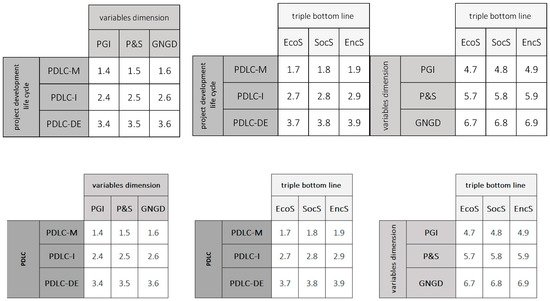
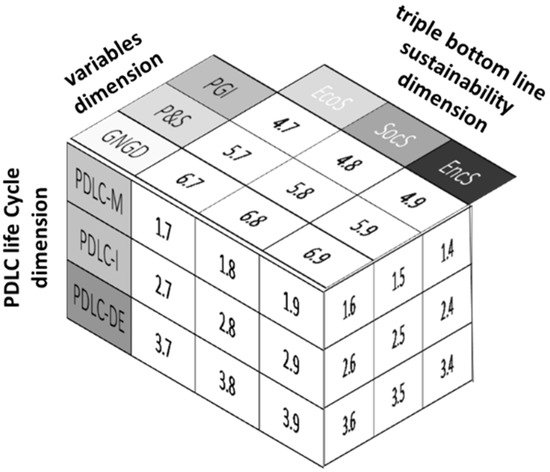
PM
The classification of sustainable practices catalogued by the project Think Twice could
be an important contribution to stimulate the sensitivity and awareness of project managers,
convincing them to adopt relevant attitudes towards sustainable goals in project development. However, it is limited to only one sustainability dimension, the ecological dimension.
To extend the range of the list of the TT’s Curated Treasury of good practices towards
the triple bottom line sustainability vision, the list was revisited and reorganized, and a
conceptual model was built to reach this vision.
The first approach to the findings led to the emergence of a second dimension combining the ecological practices into families of related actions, named the variable dimension.
Those variables are V01, Processes Green Indicators; V02, People and Systems; and V03, Go/No Go Digital or Innovation.
The group V01 corresponds to the ecological practices that are general to an organization and not specific to a given project. Instead, they are transversal actions or decisions that concern, not a specific project manager, but the organization that leads the project development. One can describe and number the scope of the observed dimensions in Table 5.
Inside this category are actions such as those regarding workplace conditions or
choices about team mobility and accommodation. An example of this kind of decision
might be: How can the project manager choose the most environmentally friendly hotel for his international team to meet at?
Such V01 good practices should be seized by specific indicators and that’s because
they were labelled as PGI (Process Green Indicator)—Process Green Indicators. These indicators should be objective and measurable to support the PM’s decision when adopting V01 practices in answering questions like: How can I compare different hotels concerning their ecological consciousness?
At this point, a new study area is identified for further research. Taking this example,
one can suggest the creation of new accommodation green metrics, such as the ones used at home for appliance energy indicators A++, A+ . . . Hotels (or even transport methods,), then, could be labelled as (say) 4-star A++.
The group V02 corresponds to practices that refer to the impact of the actions of the
team in the development of a certain project and how they affect the processes and systems that are used.
These can or cannot be generalized to the organization and are specific to the decision
of the project manager along the PDLC. As an example of this group of practices, one can have, for example: Should I print all the intermediate reports or leave them in a repository and print only the final one?
Here, also, objectivity is imperative to decide among different options. Even though
some of these decisions are common sense, they should be supported with the most
objective indicators possible.
Finally, V03 concerns the specific project and includes all the practices that bias team
decisions to use digital alternatives instead of physical solutions. This vector was named the Go/NoGo Digital dimension. This dimension may also be called digital innovation and is intended to guide project managers in choosing the border limits between the physical and the digital world.
These new classifications allow the development of a two-dimensional classification
along the life cycle. Each one of the actions under the scope of the new variables V01, V02, and V03, can be equally adopted along the project’s life cycle (Table 3).
Note that at this point the four PDLC stages adopted in the Think Twice project were
reduced to three, as the Dissemination and Evaluation phases were grouped.
So far, the exhaustive list of ecological good practices was reorganized along with
a bidimensional conceptual model based on the project life cycle and a new family of
variables described above.
The next step towards a complete list of good practices based on the holistic triple
bottom line vectors of sustainability adds all three vectors to the developed conceptual
model: the ecological sustainability vector (EcoS), the social sustainability vector (SocS), and the economic sustainability vector (EncS) (Table 4).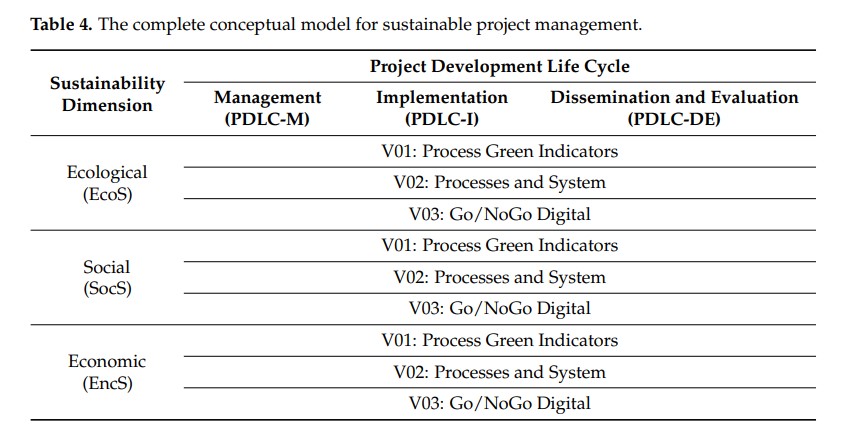
One can describe and number the scope of the observed dimensions in Table 5.
The introduction of the new vectors of sustainability dimensions requires the incorporation of an extended list of project management best practices concerning the social and the economic aspects of project development life cycle stages and variable dimensions.
Subjects such as child labour, fair trade, or extremely low wages should be addressed at this time.
The complete conceptual model based on the three dimensions is now a 3D model
in all the dimensions numbered above. This will allow the new Curated Treasury to be
redistributed according to its target dimensions, Figure 2.
The introduction of the new vectors of sustainability dimensions requires the
incorporation of an extended list of project management best practices concerning the
social and the economic aspects of project development life cycle stages and variable
dimensions. Subjects such as child labour, fair trade, or extremely low wages should be
addressed at this time.
The complete conceptual model based on the three dimensions is now a 3D model in
all the dimensions numbered above. This will allow the new Curated Treasury to be
redistributed according to its target dimensions (Figure 2)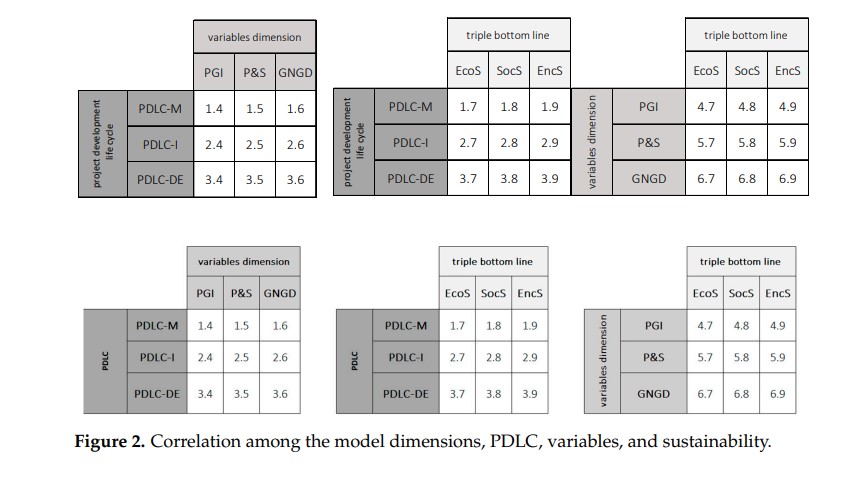 To better picture the model and easily find the axis of action, the three conceptual
To better picture the model and easily find the axis of action, the three conceptual
dimensions are depicted in a 3D view that represents the Project Management Triple
Sustainability Cube (Figure 3).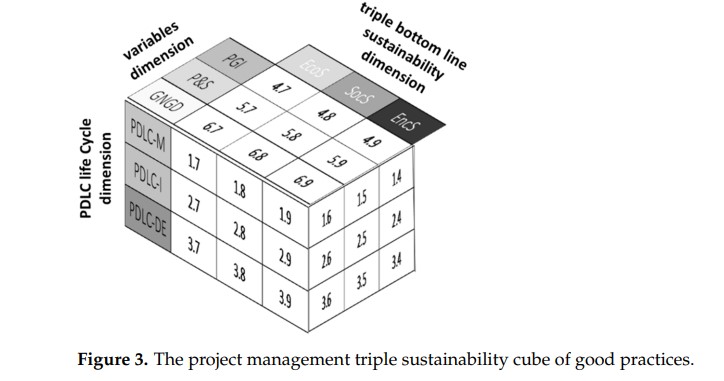
The Project Management Triple Sustainability Cube model is a conceptual model that
shows the transversality of three interrelated dimensions of sustainable project
development along the project life cycle. It identifies 3 × 9 individual areas of sustainability procedures that may be adopted by project managers in each project development.
By adopting this methodology and achieving a group of 27 practices, each project
manager could objectively identify the adoption of each group of best practices along each axis and at each stage of project implementation. By highlighting each of the 27
sustainability areas in which actions were taken in a certain project, project managers can improve and forecast improvement areas for current and subsequent projects.
The Project Management Triple Sustainability Cube outlines guidelines for adopting
comprehensive practices in relation to the triple bottom line sustainability vectors (environmental, social, economic) concerning people, processes, and innovative solutions (go/no digital) along the project development life cycle to support the decision making of sustainability-concerned project managers.
References
- Brundtland, G.H. Our Common Future: The World Commission on Environment and Development; Oxford University Press: Oxford, UK, 1987.https://sustainabledevelopment.un.org/content/documents/5987our-common-future.pdf
- United Nations. The Sustainable Development Agenda—United Nations Sustainable Development. 2019. . United Nations . Retrieved 2022-3-25
- United Nations. Transforming Our World: The 2030 Agenda for Sustainable Development. . United Nations. Retrieved 2022-3-25
- United Nations. Social Development for Sustainable Development|DISD. 2019 . United Nations. Retrieved 2022-3-25
- NeerajBhanotP. VenkateswaraRaoS.G.Deshmukh; An integrated approach for analysing the enablers and barriers of sustainable manufacturing. . Journal of Cleaner Production 2017, 142, 4412-4439, https://doi.org/10.1016/j.jclepro.2016.11.123.
- Kiron, D.; Unruh, G.; Kruschwitz, N.; Reeves, M.; Rubel, H.; Meyer Zum Felde, A.; Corporate sustainability at a crossroads, progress toward our common future in uncertain times, in collaboration with the Boston Consulting Group. MIT Sloan Manag. 2017, 18, 4.
- Baumgartner, R.J.; Rauter, R; Strategic perspectives of corporate sustainability management to develop a sustainable organization. J. Clean. Prod 2017, 140, 81–92, https://doi.org/10.1016/j.jclepro.2016.04.146.
- Blackburn, W.R. The Sustainability Handbook. The Complete Management Guide to Achieving Social, Economic and EnvironmentalResponsability; Earthsca: London, UK; New York, NY, USA, 2007.
- Elkington, J.; Partnerships fromcannibals with forks: The triple bottom line of 21st-century business. Environ. Qual. Manag 1998, 8, 37-51.
- Silva, C.S.; Gouveia, J.B. International Management Conference. In Proceedings of the A Implementação Da Sustentabilidade NaGestão Das Organizações: Análise De Relatórios De Sustentabilidade, Aveiro, Portugal, 26 June 2015; pp. 45–54.
- Labuschagne, C.; Brent, A.C.; Sustainable Project Life Cycle Management: The need to integrate life cycles in the manufacturing sector. Int. J. Proj. Manag. 2005, 23, 159–168.
- Kivilä, J.; Martinsuo, M.; Vuorinen, L. Sustainable project management through project control in infrastructure projects. Int. J. Proj. Manag. 2017, 35, 1167–1183.
- Silvius, A.J.G.; Schipper, R. Sustainability in the Business Case. In Proceedings of the 26th IPMA World Congress, Crete, Greece,29–31 October 2012; pp. 1062–1069
- Eid, M. Sustainable Development & Project Management; Lambert Academic Publishing: Cologne, Germany, 2009.
- Maltzman, R.; Shirley, D. Project Manager as a Pivot Point for Implementing Sustainability in an Enterprise; IGI Global LLC: Hershey,PA, USA, 2013.
- ISO. ISO 21505:2017-Project, Program and Portfolio Management; International Organization for Standardization: Geneva, Switzerland, 2017
- Huemann, M.; Silvius, G. Projects to Create the Future: Managing Projects Meets Sustainable Development; Elsevier: Amsterdam, The Netherlands, 2017.
- Marcelino-Sádaba, S.; González-Jaen, L.F.; Pérez-Ezcurdia, A. Using project management as a way to sustainability. From a comprehensive review to a framework definition. J. Clean. Prod. 2015, 99, 1–16
- Labuschagne, C.; Brent, A.C. Sustainable Project Life Cycle Management: The need to integrate life cycles in the manufacturing sector. Int. J. Proj. Manag. 2005, 23, 159–168
- Marnewick, C.; Silvius, G.; Schipper, R. Exploring Patterns of Sustainability Stimuli of Project Managers. Sustainability 2019,11, 5016
- Jonny Klakegg, O. Pursuing relevance and sustainability: Improvement strategies for major public projects. Int. J. Manag. Proj. Bus. 2009, 2, 499–518.
- Corder, G.D.; McLellan, B.C.; Green, S. Incorporating sustainable development principles into minerals processing design and operation: SUSOP®. Miner. Eng. 2010, 23, 175–181.
- Tharp, J. Sustainability in Project Management: Practical Applications. In Sustainability Integration for Effective Project Management; Silvius, A.J.G., Tharp, J., Eds.; IGI Global Publishing: Hershey, PA, USA, 2013; pp. 182–193.
- Magano, J.; Silva, C.S.; Martins, M. Project Management in the Biotech Context: Exploring theInterrelation between Maturity and SustainableProject Management. Sustainability 2021, 13, 12090.
- Morris, A.; Wilkinson, S.; Algeo, C.; Candusso, D. Project management maturity levels and organizational revenue in New South Wales local government. J. Mod. Proj. Manag. 2020, 8, 158–166.
- Kivilä, J.; Martinsuo, M.; Vuorinen, L. Sustainable project management through project control in infrastructure projects. Int. J. Proj. Manag. 2017, 35, 1167–1183.
- Marnewick, C.; Silvius, G.; Schipper, R. Exploring Patterns of Sustainability Stimuli of Project Managers. Sustainability 2019, 11, 5016.
- Armenia, S.; Dangelico, R.M.; Nonino, F.; Pompei, A. Sustainable project management: A conceptualization-oriented review and a framework proposal for future studies. Sustainability 2019, 11, 2664.
- Ebbesen, J.B.; Hope, A.J. Re-imagining the Iron Triangle: Embedding Sustainability into Project Constraints. PM World J. 2013, 2, 1–13.
- Elkington, J. Partnerships fromcannibals with forks: The triple bottom line of 21st-century business. Environ. Qual. Manag. 1998, 8, 37–51
- Amiril, A.; Nawawi, A.H.; Takim, R.; Latif, S.N.F.A. Transportation Infrastructure Project Sustainability Factors and Performance. Procedia Soc. Behav. Sci. 2014, 153, 90–98.
- Bond, A.; Morrison-Saunders, A.; Pope, J. Sustainability assessment: The state of the art. Impact Assess. Proj. Apprais. 2012, 30, 53–62.
- Shen, L.; Wu, Y.; Zhang, X. Key Assessment Indicators for the Sustainability of Infrastructure Projects. J. Constr. Eng. Manag. 2010, 137, 441–451.
- Aarseth, W.; Ahola, T.; Aaltonen, K.; Økland, A.; Andersen, B. Project sustainability strategies: A systematic literature review. Int. J. Proj. Manag. 2017, 35, 1071–1083.
- Kolltveit, B.J.; Grønhaug, K. The importance of the early phase: The case of construction and building projects. Int. J. Proj. Manag. 2004, 22, 545–551.
- Wu, Z.; Pagell, M. Balancing priorities: Decision-making in sustainable supply chain management. J. Oper. Manag. 2011, 29, 577–590.
- Boz, M.A.; El-adaway, I.H. Creating a Holistic Systems Framework for Sustainability Assessment of Civil Infrastructure Projects. J. Constr. Eng. Manag. 2014, 141, 04014067.
- Kolltveit, B.J.; Karlsen, J.T.; Grønhaug, K. Perspectives on project management. Int. J. Proj. Manag. 2007, 25, 3–9.
- Hansen, E.G.; Grosse-Dunker, F.; Reichwald, R. Sustainability innovation cube—A framework to evaluate sustainability-oriented innovations. Int. J. Innov. Manag. 2009, 13, 683–713.
- Crawford, L. Senior management perceptions of project management competence. Int. J. Proj. Manag. 2005, 23, 7–16.
- Tam, G. The program management process with sustainability considerations. J. Proj. Progr. Portf. Manag. 2010, 1, 17–27.
- Silvius, G.; Schipper, R. Exploring variety in factors that stimulate project managers to address sustainability issues. Int. J. Proj. Manag. 2020, 38, 353–367
- Ahmad, W.; Soskolne, C.L.; Ahmed, T. Strategic thinking on sustainability: Challenges and sectoral roles. Environ. Dev. Sustain. 2011, 14, 67–83.
- Think Twice! . Think Twice!. Retrieved 2022-3-28
- Think Twice! . Think Twice!. Retrieved 2022-3-28
